Тарханы сочинение на английском
Обновлено: 07.07.2024
После ознакомления с содержанием Топика ( Сочинения ) по теме “О себе” Советуем каждому из вас обратить внимание на дополнительные материалы. Большинство из наших топиков содержат дополнительные вопросы по тексту и наиболее интересные слова текста. Отвечая на не сложные вопросы по тексту вы сможете максимально осмыслить содержание Топика ( Сочинения ) и если вам необходимо написать собственное Сочинение по теме “О себе” у вас возникнет минимум сложностей.
Если у вас возникают вопросы по прочтению отдельных слов вы можете дважды нажать на непонятное слово и в нижнем левом углу в форме перевода есть отдельная кнопка которая позволит вам услышать непосредственно произношение слова. Или также вы можете пройти к разделу Правила Чтения Английского Языка и найти ответ на возникший вопрос.
My Favourite Writer (M. Lermontov)
One of Russia’s most celebrated poets of all times, Michael Lermontov was born in Moscow in the family of a nobleman. He spent his childhood and youth in Tarckany, in the province of Penza.
In 1830 Lermontov entered the Moscow University, but very soon he had to leave it. Then he entered St. Petersburg School of Cavalry Cadets. He finished it and served in the Hussar Regiment of the Imperial Guard.
In 1837 the poet was exiled to the Caucasus for his poem “Poets Death”. In 1840 Lermontov was exiled to the Caucasus for the second time. He was provoked into personal quarrel with his schoolmate. The quarrel led to a duel. On July 15th, 1841 the poet was killed. He was not even 27 at that time.
Lermontov began writing when he was very young. One of his first writings to be published was his verse tale “Hadji Arbek”.
But he won fame as a poet after his poem “Poets Death” was published. Lermontov’s poems “Demon” “Mtsyri” his great novel “A Hero of Our Time” and his play “Masquerade” are masterpieces of Russian literature.
Whether he wrote poetry, drama or prose, the stamp of his genius was to be found on his works. Lermontov’s influence as of a poet and a thinker on all Russian writes can’t be overestimated.
Мой любимый писатель (М. Лермонтов)
Главная /
Темы топиков /
Известные люди-Famous people /
Мой любимый писатель (М. Лермонтов)-My Favourite Writer (M. Lermontov)
Топик по английскому языку “My Favourite Writer (M. Lermontov) – Мой любимый писатель (М. Лермонтов)”
One of Russia’s most celebrated poets of all times, Michael Lermontov was born in Moscow in the family of a nobleman. He spent his childhood and youth in Tarckany, in the province of Penza.
In 1830 Lermontov entered the Moscow University, but very soon he had to leave it. Then he entered St. Petersburg School of Cavalry Cadets. He finished it and served in the Hussar Regiment of the Imperial Guard.
In 1837 the poet was exiled to the Caucasus for his poem “Poets Death”. In 1840 Lermontov was exiled to the Caucasus for the second time. He was provoked into personal quarrel with his schoolmate. The quarrel led to a duel. On July 15th, 1841 the poet was killed. He was not even 27 at that time.
Lermontov began writing when he was very young. One of his first writings to be published was his verse tale “Hadji Arbek”.
But he won fame as a poet after his poem “Poets Death” was published. Lermontov’s poems “Demon” “Mtsyri” his great novel “A Hero of Our Time” and his play “Masquerade” are masterpieces of Russian literature.
Whether he wrote poetry, drama or prose, the stamp of his genius was to be found on his works. Lermontov’s influence as of a poet and a thinker on all Russian writes can’t be overestimated.
Перевод топика: Мой любимый писатель (М. Лермонтов)
Vocabulary:
Questions:
Представлено сочинение на английском языке Мой любимый писатель/ My Favourite Writer с переводом на русский язык. Бесплатное скачивание.
Reading is the pleasant and useful part of our life. People like reading. I think so because a lot of books are bought and sold every day in different bookshops and in streets (or: outside) too. Of course, radio and television are more popular among people but books still play an important role for us. Reading enriches our mind. It can satisfy many different demands and literary tastes. It reveals to us its own world of life, which is sometimes cruel or sorrowful and sometimes is joyful or fantastic.
Speaking about reading I can’t help saying about my favourite writer. He is one of the most famous Russian authors of the 19th century – Mikhail Yurievich Lermontov.
His life was momentary and blinding as a gleam of lightning in a stormy sky.
Not having lived till 27 years old, he passed the entire circle of life with flights of inspiration and bitterness of disappointments. He went through many troubles in his life: great success and two exiles, disappointments and love, smoke of battles and intrigues of a high society.. And died in thunderstorm… This is the entire circle.
Just two latest figures changed their places in the dates of his life. But how many emotions were experienced by him and what antagonism of ideas existed in his mind and soul!
I like novels, stories and poems by Mikhail Lermontov very much. Needless to say that the most part of the poems and almost all novels and stories are full of melancholy – this is the particularity of his works.
No doubt, all of us have read his poems at school and of course have got acquainted with “The Hero of Our Time”. In this novel through the heroes Lermontov tried to express his own sense of time and events.
The main character is Grigoriy Alexandrovich Pechorin – an individualist with a conflict in his sole. He disdains a high society and searches for a real affair, where he could apply his skills and his talents, where he could put his soul. But he doesn’t find such an affair and suffers from it.
Pechorin is a deep character. He is like his author, a man who searches for real life, deep feelings, true love and feels useless in his time.
Lermontov never wrote non-fiction. All his compositions are made-up but a great part of them is connected with real events of the 19th and other centuries. There is no humor in his works, they are deep and full of the author’s thoughts. They reflect the problems of the society and make us think. That is why I like them very much and enjoy every minute, reading books by Mikhail Yurievich Lermontov.
Чтение – приятная и полезная часть нашей жизни. Люди любят читать. Я так думаю, потому что много книг покупается и продается ежедневно в разных книжных магазинах и также на улицах. Конечно, радио и телевидение более популярны среди людей, но книги все еще играют важную роль для нас. Чтение обогащает наш ум. Оно может удовлетворить множество разных потребностей и литературных вкусов. Оно открывает нам свой собственный мир жизни, который иногда жесток или печален, а иногда – радостен и фантастичен.
Говоря о чтении, я не могу не сказать о моем любимом писателе. Он – один из наиболее знаменитых русских авторов 19-го века – Михаил Юрьевич Лермонтов.
Его жизнь была коротка (досл. – мгновенна) и ослепляющая, как вспышка молнии на штормовом небе.
Не дожив до 27 лет, он прошел полный круг жизни с творческими подъемами (досл. – полетами вдохновения) и горечью разочарований. В своей жизни он прошел через многие трудности: огромный успех и две ссылки, разочарования и любовь, дым сражений и интриги высшего общества… И погиб в грозу. Это – полный круг.
Только последние две цифры поменялись местами в датах его жизни. Но как много эмоций он прочувствовал, и какой антагонизм (антагонизм – противопоставление) идей существовал в его уме и душе!
Я очень люблю романы, повести и стихотворения Михаила Лермонтова. Нет нужды говорить, что большая часть его стихотворений и почти все романы и повести полны меланхолии – это характерная черта его работ.
My Favourite Writer
Мой любимый писатель
Мне нравятся многие произведения русской и зарубежной литературы. Несмотря на впечатляющий список великих писателей всех времен и народов, лично для себя я давно выбрала любимого писателя – это М.Ю. Лермонтов. Без сомнений, Лермонтов – это один из гениальнейших русских писателей, его произведения отличает реализм, злободневность, они актуальны во все времена.
Лермонтов прожил весьма короткую жизнь, но за это время он успел создать огромное количество блестящих произведений, он стал новатором, создав первый психологический роман, в котором проанализировал личность человека, где в одном герое отразил черты современников.
Во многом произведения Лермонтова автобиографичны, зачастую он описывал свое окружение или события, которые происходили в его жизни.
Известно, что М.Ю. Лермонтов был верным поклонником творчества А.С. Пушкина, а в ранних произведениях Лермонтова особенно заметно подражание Пушкину.
Меня особенно восхищают герои, созданные Лермонтовым. Они волевые, целеустремленные, они остаются до конца верны своим идеалам, они непоколебимы. Лермонтов мастерски создал образы, которые до сих пор волнуют душу и сердца читателей.
Произведения Лермонтова очень разноплановые, в каких-то произведениях я нахожу мотивацию и призыв к действию, другие же способны подбодрить меня, когда мне грустно.
Мне очень близки произведения М.Ю. Лермонтова, погружаясь в чтение его трудов, я понимаю, что я не одинока в этой мире, я наблюдаю за переживаниями других людей, наблюдаю за их поступками, вижу противоречия, которые они испытывают.
Я считаю, что труды Лермонтова поучают людей. Меня вдохновляют его герои, я тоже хочу быть сильной духом и не сдаваться перед серьезными препятствиями.
М.Ю. Лермонтов – один из известнейших писателей и поэтов России. Его произведения нужно читать в любом возрасте, перечитывать, чтобы открывать новые грани, новые мысли после прочтения. Лермонтов пишет так просто и изящно, его наследие всегда будет будоражить умы людей.
My favourite writer is Anton Pavlovich Chekhov. In my opinion, he is the greatest Russian dramatist and short-story writer. I’m never tired of reading and rereading his plays and humorous stories.
Chekhov was bom in 1860 in Taganrog. In 1879 he went to Moscow, where he studied medicine. Though he practised little as a doctor in his lifetime, he was prouder of his medical knowledge than of his writing talent.
While in college, Chekhov wrote humorous sketches for comic papers to support his family. He collected the best ones into a volume, Motley Stories, in 1886. The book attracted the attention of the publisher of the Novoje Vfemja, Russia’s largest paper, and Chekhov was asked to contribute stories regularly.
Chekhov, as an established writer, was able to develop a style of his own. Though he never gave up writing comic stories, he began working in a more serious vein. In 1887 Ivanov, his first play, established Chekhov as a dramatist.
From then on, he concentrated on writing plays, as well as short stories.
Chekhov was seriously ill. He had tuberculosis and knew what it meant. By 1892 his health was so bad that he was afraid to spend another winter in Moscow. He bought a small estate near a village Melikhovo, 50 miles from Moscow. He spent 5 years there, and those were happy years in spite of the illness. He wrote some of his best stories there, including Ward No.6, several well-known one-act comedies and two of his serious dramatic masterpieces, The Seagull and Uncle Vanya.
The Seagull was first staged in the Alexandrinsky Theatre in Petersburg. It was a complete failure because of the dull and clumsy production. It was a cruel blow to Chekhov. However, the play was successfully performed as the first production of the Moscow Art Theatre in 1898. From then on, Chekhov was closely connected with this theatre and with its founder, K.S. Stanislavsky. In 1901 he married an Art Theatre actress, Olga Knipper, who acted in his play The Three Sisters the same year.
Chekhov’s health went from bad to worse and he had to spend the remaining years in the Crimea and other health spas.
The Cherry Orchard, his last play, was produced in 1904. Soon after the first night Chekhov died. He was 44.
Chekhov had an immense influence on the 20th century drama. Besides, several generations of writers both in Russia and abroad studied and imitated Chekhov to perfect their own literary style.
Перевод
Мой любимый писатель- Антон Павлович Чехов. По-моему, он самый великий русский драматург и автор коротких рассказов. Я никогда не устаю читать и перечитывать его пьесы и юмористические рассказы.
Чехов родился в Таганроге в 1860 году. В 1879 году он уехал в Москву, где изучал медицину. Хотя он мало практиковал как врач в своей жизни, он гордился своими медицинскими знаниями больше, чем писательским талантом.
В университете, Чехов писал юмористические эскизы для газет, чтобы поддерживать свою семью. Он собрал лучшие в сборник “Пестрые рассказы”, в 1886 году. Книга привлекла внимание издателя Нового Времени, крупной газеты в России, и Чехову было предложено сотрудничать регулярно.
Чехову, как признаному писателю, удалось разработать свой собственный стиль. Хотя он никогда не бросал писать юмористические рассказы, он начал работать в более серьезном ключе. В 1887 “Иванов”, первая пьеса, созданная Чеховым, ознаменовала его как драматурга.
С тех пор он сконцентрировался на написании пьес, а также коротких рассказов.
Чехов был серьезно болен. Он болел туберкулезом и знал, что это значит. К 1892 его здоровье было настолько плохо, что он боялся провести еще одну зиму в Москве. Он купил небольшое имение близ деревни Мелихово, в 50 милях от Москвы. Он провел там 5 лет, и это были счастливые годы, несмотря на болезнь. Он написал там несколько своих лучших рассказов , в том числе “Палата № 6”, несколько известных одноактных комедий и два серьезных драматических шедевра, “Чайка” и “Дядя Ваня”.
“Чайка” была впервые поставлена в Александринском театре в Петербурге. Это был полный провал из-за скучной и неуклюжой постановки. Это было жестоким ударом для Чехова. Тем не менее, пьеса была успешно поставлена Московским Художественным театром в 1898 году. С тех пор, Чехов была тесно связан с этим театром, и с его основателем, К. С. Станиславским. В 1901 г. он женился на актрисе МХАТ, О. Л. Книппер, которая играла в его пьесе “Три сестры” в том же году.
Здоровье Чехова становилось все хуже и хуже, и ему пришлось провести оставшиеся годы в Крыму и других курортах.
“Вишневый сад “, свою последнюю пьесу он выпустил в 1904 году. Вскоре после премьеры Чехов скончался. Ему было 44.
Чехов оказал огромное влияние на драму двадцатого века. Кроме того, несколько поколений писателей в России и за рубежом изучали его творчество и подражали ему, чтобы совершенствовать свой собственный литературный стиль.

Данная презентация окажет помощь при проведении внеклассного мероприятия по английскому языку по теме: "Тарханы". Кроме того, будет полезна для самостоятельного изучения темы.

GA POY PO PKTT Topic: Tarkhany
Student: Vodolazhskaya Alexandra
Professor: Kopieva Olga Ivanovna.
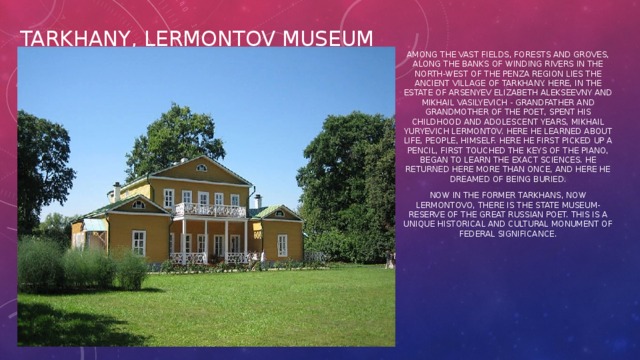
Tarkhany, Lermontov Museum
Among the vast fields, forests and groves, along the banks of winding rivers in the north-west of the Penza region lies the ancient village of Tarkhany. Here, in the estate of Arsenyev Elizabeth Alekseevny and Mikhail Vasilyevich - grandfather and grandmother of the poet, spent his childhood and adolescent years, Mikhail Yuryevich Lermontov. Here he learned about life, people, himself. Here he first picked up a pencil, first touched the keys of the piano, began to learn the exact sciences. He returned here more than once, and here he dreamed of being buried.
Now in the former Tarkhans, now Lermontovo, there is the State Museum-Reserve of the great Russian poet. This is a unique historical and cultural monument of federal significance.
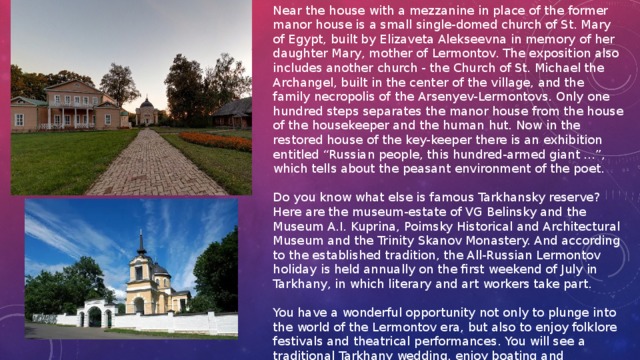
Near the house with a mezzanine in place of the former manor house is a small single-domed church of St. Mary of Egypt, built by Elizaveta Alekseevna in memory of her daughter Mary, mother of Lermontov. The exposition also includes another church - the Church of St. Michael the Archangel, built in the center of the village, and the family necropolis of the Arsenyev-Lermontovs. Only one hundred steps separates the manor house from the house of the housekeeper and the human hut. Now in the restored house of the key-keeper there is an exhibition entitled “Russian people, this hundred-armed giant . ”, which tells about the peasant environment of the poet.
Do you know what else is famous Tarkhansky reserve? Here are the museum-estate of VG Belinsky and the Museum A.I. Kuprina, Poimsky Historical and Architectural Museum and the Trinity Skanov Monastery. And according to the established tradition, the All-Russian Lermontov holiday is held annually on the first weekend of July in Tarkhany, in which literary and art workers take part.
You have a wonderful opportunity not only to plunge into the world of the Lermontov era, but also to enjoy folklore festivals and theatrical performances. You will see a traditional Tarkhany wedding, enjoy boating and horseback riding, take part in master classes that teach old Tarkhany crafts.
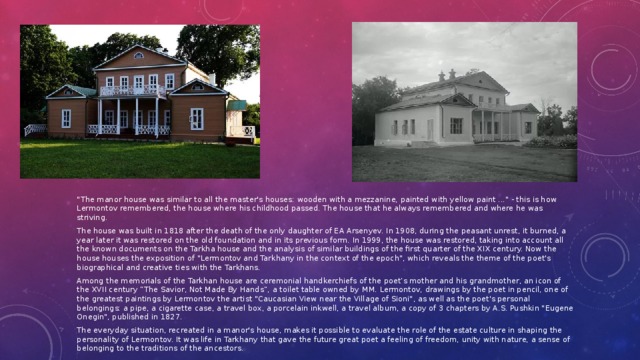
"The manor house was similar to all the master's houses: wooden with a mezzanine, painted with yellow paint . " - this is how Lermontov remembered, the house where his childhood passed. The house that he always remembered and where he was striving.
The house was built in 1818 after the death of the only daughter of EA Arsenyev. In 1908, during the peasant unrest, it burned, a year later it was restored on the old foundation and in its previous form. In 1999, the house was restored, taking into account all the known documents on the Tarkha house and the analysis of similar buildings of the first quarter of the XIX century. Now the house houses the exposition of "Lermontov and Tarkhany in the context of the epoch", which reveals the theme of the poet's biographical and creative ties with the Tarkhans.
Among the memorials of the Tarkhan house are ceremonial handkerchiefs of the poet’s mother and his grandmother, an icon of the XVII century “The Savior, Not Made By Hands”, a toilet table owned by MM. Lermontov, drawings by the poet in pencil, one of the greatest paintings by Lermontov the artist "Caucasian View near the Village of Sioni", as well as the poet's personal belongings: a pipe, a cigarette case, a travel box, a porcelain inkwell, a travel album, a copy of 3 chapters by A.S. Pushkin "Eugene Onegin", published in 1827.
The everyday situation, recreated in a manor's house, makes it possible to evaluate the role of the estate culture in shaping the personality of Lermontov. It was life in Tarkhany that gave the future great poet a feeling of freedom, unity with nature, a sense of belonging to the traditions of the ancestors.

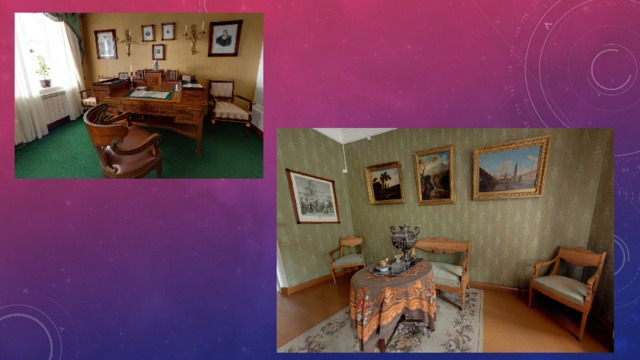
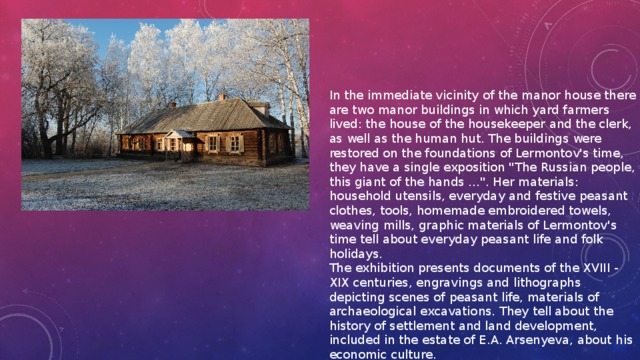
In the immediate vicinity of the manor house there are two manor buildings in which yard farmers lived: the house of the housekeeper and the clerk, as well as the human hut. The buildings were restored on the foundations of Lermontov's time, they have a single exposition "The Russian people, this giant of the hands . ". Her materials: household utensils, everyday and festive peasant clothes, tools, homemade embroidered towels, weaving mills, graphic materials of Lermontov's time tell about everyday peasant life and folk holidays.
The exhibition presents documents of the XVIII - XIX centuries, engravings and lithographs depicting scenes of peasant life, materials of archaeological excavations. They tell about the history of settlement and land development, included in the estate of E.A. Arsenyeva, about his economic culture.

In 1794, the young spouses Mikhail Vasilyevich and Elizaveta Alekseevna Arsenyev - grandfather and grandmother M.Yu. Lermontov - bought an estate in Chembarsky district and began to equip the estate. The aesthetic side of the arrangement involved Mikhail Vasilyevich.
The new manor was divided into two parts: a front door (with a house and a park) and an economic (with outbuildings).
From the manor house opened three main specific perspectives. Western represented a wide panorama of the Big Pond and the village with the church. South opened to the gaze a wide linden alley through the Round Garden into the Oak Grove. To the east you could see the alley of the Far Garden. On the western side of the estate there were no buildings, and right behind the house there began a “magnificent garden located in a semi-mountain” and a park.
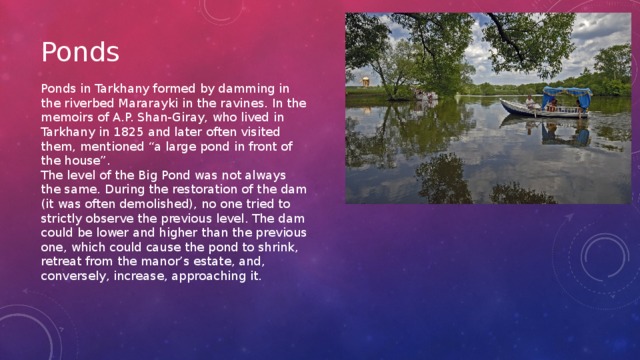
Ponds in Tarkhany formed by damming in the riverbed Mararayki in the ravines. In the memoirs of A.P. Shan-Giray, who lived in Tarkhany in 1825 and later often visited them, mentioned “a large pond in front of the house”.
The level of the Big Pond was not always the same. During the restoration of the dam (it was often demolished), no one tried to strictly observe the previous level. The dam could be lower and higher than the previous one, which could cause the pond to shrink, retreat from the manor’s estate, and, conversely, increase, approaching it.
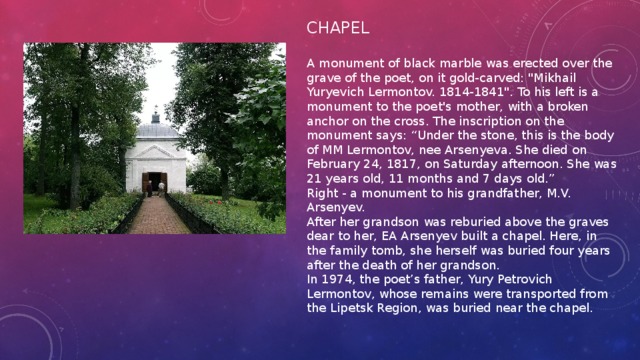
A monument of black marble was erected over the grave of the poet, on it gold-carved: "Mikhail Yuryevich Lermontov. 1814-1841". To his left is a monument to the poet's mother, with a broken anchor on the cross. The inscription on the monument says: “Under the stone, this is the body of MM Lermontov, nee Arsenyeva. She died on February 24, 1817, on Saturday afternoon. She was 21 years old, 11 months and 7 days old.”
Right - a monument to his grandfather, M.V. Arsenyev.
After her grandson was reburied above the graves dear to her, EA Arsenyev built a chapel. Here, in the family tomb, she herself was buried four years after the death of her grandson.
In 1974, the poet’s father, Yury Petrovich Lermontov, whose remains were transported from the Lipetsk Region, was buried near the chapel.
Manor after the death of Lermontov
After the tragic death of the poet and Arsenyev’s death, according to her will, Tarkhany’s estate passed to A. A. Stolypin. Lermontov Manor was actually transferred to the administration of I. A. Sokolov, since Afanasy Alekseevich resided permanently in the Saratov province. In 1867, P. N. Zhuravlev, an educated person who understands the significance of the manor, replaced Gorchakov’s manager at his post.
He completely restored the manor house. In addition, he provided invaluable assistance in the collection of materials about the grandmother of the poet, his teenage and adolescent years in the Tarkhany. This man ruled the estate for 35 years, died in 1902, and was buried near the church of Michael the Archangel. The idea of creating a museum in "Tarkhany" was first voiced in 1905 in the "Penza Gazette".
The restoration was completed in 1938. In the spring of 1939, visitors were allowed access to the poet’s grave, and on May 30, the grand opening of the Lermontov Museum took place. About 2,000 people convened for a rally dedicated to this event. In the very first years of its activity, the museum had a single exhibition building - a manor house. It all told about the life and work of the great poet.
In 1944, the Lermontov Museum was renamed the Manor Museum. In 1948, the USSR Council of Ministers allocated 9.6 hectares of land for this purpose. In 1960, "Tarkhany" (Lermontov estate) included in the list of culture and history of Russia.
Since 1969, the former estate is the State Museum-Reserve. Homestead Today At present, the museum includes a manor’s estate with a complex of monuments from the late 17th and early 19th centuries, the ancestral necropolis of the Arsenyev – Lermontovs, and the Apaliha estate, located not far from the Tarkhans.
Here the young poet often visited his beloved aunt MA Shan-Girey. The first major stage of restoration of protected objects was carried out in the 80s of the last century.
Географическое положение: Penza is a city located in the center of the European part of Russia, on the Sura River. – Пенза – город, расположенный в центре европейской части России, на реке Сура.
p, blockquote 1,0,0,0,0 -->
Дата основания: The city was founded in 1663 as a fortress to protect the country against the nomads. – Город был основан в 1663 году как крепость для защиты страны от кочевников.
Достопримечательности Пензы: общая информация
p, blockquote 2,0,1,0,0 -->
There are a lot of old streets and magnificent buildings in Penza. The main street of Penza is Moskovskaya Street. Its beauty takes breath away as well as the entire view of the city from the Ferris wheel in Belinsky Park. – В Пензе много старых улиц и великолепных зданий. Улица Московская – главная улица в городе. От ее красоты захватывает дух, так же, как и от вида на весь город с колеса обозрения в парке Белинского.
p, blockquote 3,0,0,0,0 -->
p, blockquote 4,0,0,0,0 -->
Orthodox Church of the Transfiguration – is the oldest building in Penza, built in 17th century. Uspensky Cathedral, Pokrovsky Cathedral and Chapel of the Archangel Michael are worth seeing as the parts of unique cultural heritage. – Церковь Преображения Господня – самое старое здание Пензы, построенное в 17 веке. Успенский собор, Покровский собор и Часовня Михаила Архангела обязательны к посещению как элементы уникального культурного наследия.
p, blockquote 5,1,0,0,0 -->
p, blockquote 6,0,0,0,0 -->
Belinsky Park is one of the oldest parks in Russia. It is wonderful place for resting and enjoying the beauty of ancient trees. – Парк Белинского – один из самых старых парков России. Это удивительное место для отдыха и наслаждения красотой вековых деревьев.
p, blockquote 7,0,0,0,0 -->
p, blockquote 8,0,0,1,0 -->
Penza’s museums never leave visitors untouched. Be sure to visit Literary Museum, Penza State Museum of Local Lore, Folk Museum, and The Penza Regional Art Gallery of K.A. Savitskiy. – Пензенские музеи никогда не оставляют посетителей равнодушными. Обязательно посетите Литературный музей, Пензенский государственный краеведческий музей, Музей народного творчества, Пензенскую областную картинную галерею им. К.А. Савицкого.
p, blockquote 9,0,0,0,0 -->
p, blockquote 10,0,0,0,0 --> p, blockquote 11,0,0,0,1 -->
В английский Тарханов означает: Tarkhanov (мы нашли 1 переводов). Есть не менее 21 примеров предложений с Тарханов . Среди прочего: Он увидел, что дерется с самим тарханом. ↔ He found he was fighting the Tarkaan himself. .
Тарханов
переводы Тарханов
Tarkhanov
Подобные фразы
Примеры
Разумеется, Шаста просил Коня рассказать о войнах и битвах, где тот участвовал вместе со своим тарханом.
And then of course Shasta begged to be told of the battles and wars in which Bree had carried the Tarkaan.
In Cyprus, it is considered a national specialty, and is often served with pieces of haloumi cheese in it.
The first novella of the anthology – "Anna on the Neck" – is the story of Anna Petrovna (Maria Strelkova), who has at a young age become the wife of middle-aged venerable official Modest Alexeyevich (Michael Tarhanov).
Что касается статьи 3 Конвенции и того, что ускоренная процедура рассмотрения ходатайства о предоставлении убежища не имеет отлагательного действия, он отмечает, что, как сообщает "Международная амнистия", тунисский проситель убежища Хусин Тархани был принудительно выдворен из Франции в Тунис в июне 2007 года, хотя продолжала рассматриваться апелляция в связи с его ходатайством о предоставлении убежища.
With reference to article 3 of the Convention and the fact that the accelerated asylum procedure did not have suspensive effect, he noted that, according to Amnesty International, a Tunisian asylum-seeker, Houssine Tarkhani, had been forcibly returned from France to Tunisia in June 2007 even though an appeal had been pending in relation to his claim for asylum.
Between the years 1892 and 1904, Tarkhanov contributed nearly 160 articles, from B to Z, in physiology and medicine to the Brockhaus and Efron Encyclopedic Dictionary.
Такой призыв не мог не иметь отрицательного значения, ибо мешал простому населению объединиться с русскими крестьянами для совместной борьбы против настоящих врагов — русских дворян, офицеров, чиновников, тарханов, мурз, старшин.
Бындай өндәмәнең кире тәьҫирен билдәләп үтергә кәрәк, сөнки ул ысын иҙеүселәргә — рус дворяндары, офицерҙары, чиновниктары, тархандар, мырҙалар һәм старшиналарға ҡаршы көрәшеү өсөн ябай халыҡтың рус крәҫтиәндәре менән берләшеүенә ҡамасаулаған.
В своих публикациях Тарханов выступает как прогрессивный учёный-гуманист, борющийся за справедливость во всех сферах общественной жизни.
He appears through his writings as a progressive humanist scholar, struggling for justice in all areas of public life and many others.
Почему бы вашему великому тархану не выйти самому и не сразиться, вместо того, чтобы посылать вас на смерть?
Читайте также:

